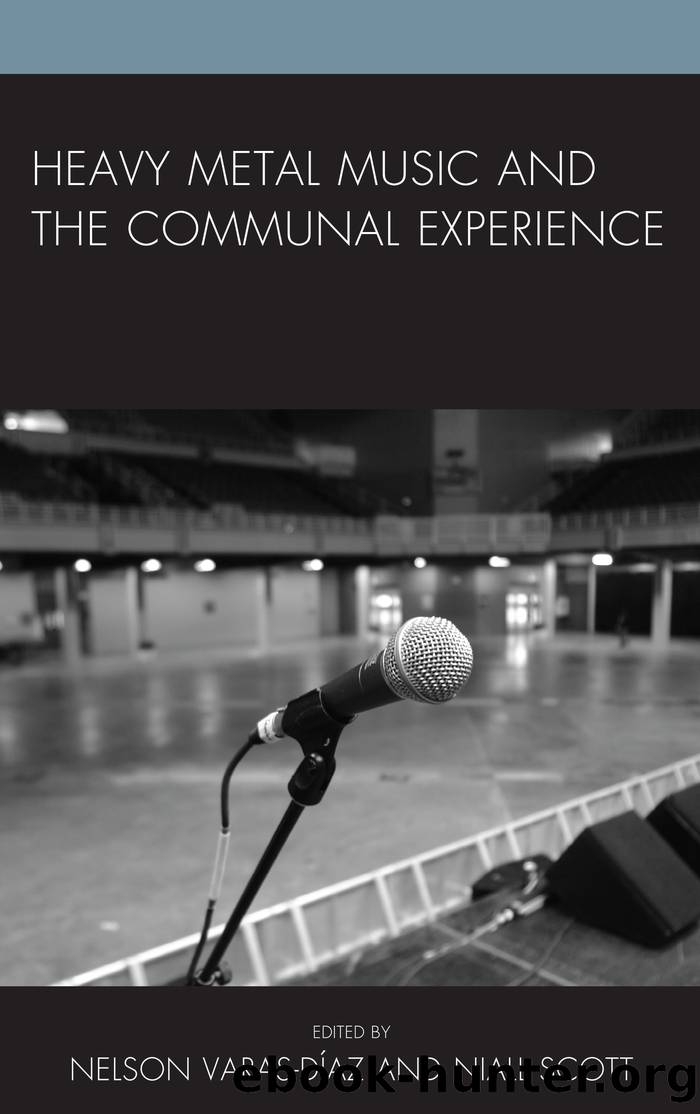Heavy Metal Music and the Communal Experience by unknow

Author:unknow
Language: eng
Format: epub
Tags: undefined
Publisher: Lexington Books/Fortress Academic
Published: 2012-08-15T00:00:00+00:00
Porous Communities
As stated before, scholarly work on the communal experience has placed an important focus on how communities are formed via inclusion criteria that yield collective identity narratives and experiences through the establishment of borders. Some of these efforts have simultaneously taken into consideration how those groups are embedded in particular cultural contexts that help shape their communal experience. This has become an important line of research as metal continues to spread to evermore-varied geographies.
Wallach, Berger, and Greeneâs work on metal and globalization has challenged and motivated scholars to understand this musical genre as an ever-expanding global phenomenon that is present in diverse cultural settings (Wallach, Berger, and Greene 2012). This invitation to explore metal from a pluralistic perspective has been echoed by many researchers engaged in efforts to understand how metal scenes are formed throughout the world. This has been an ongoing agenda that has yielded research in diverse settings like Nepal (Green 2012), Israel (Kahn-Harris 2012), Japan (Kawano and Hosokawa 2012), Malta (Bell 2012), Turkey (Hecker 2012), South Africa (Hoad 2014), Puerto Rico (Varas-DÃaz et al. 2014) and Egypt (LeVine 2008), just to name a selection. These studies have been crucial to further understand how metal has been received in these settings and how consumers, when possible, have constituted communal experiences centered on the musical genre throughout the world. More importantly, they have shed light on how the local cultural context in which these groups are embedded can influence communal formation, both in a positive or negative manner.
One particular way in which we can examine the influence of local culture on metal is through the music and accompanying practices being created in a specific community. Metal has its particular cannons and rules for sounds, images, and performances that allow individuals to identify it as distinct from other musical genres. Still, this does not mean that these practices and the communities that are created around it are isolated from their context (Varas-DÃaz and Mendoza 2015). This is particularly true for bands that have integrated elements of their cultural context into their sound and aesthetic practices (Varas-DÃaz et al. 2014). We are using the concept of cultural context to reflect a wide variety of constructs that are characteristic of the setting in which a musical community is embedded. This can include references to national origin or ethnic composition of the community under examination. This integration of the local into metal is clearly evident in bands that embrace elements of their cultural setting into their music, including but not limited to: instrumentation, visual images, and lyrical content.
Latin America is a great example to evidence how metal communities have relaxed their borders in order to interact with the local cultural context. The region is rich in a vast diversity of languages, ethnic groups, nationalities and cultural practices that are sometimes not discussed or outright overlooked at the epicenters of metal production or academic scholarship. As a quick example for the uninitiated in Latin American metal, Table 6.1 provides a summary of bands
Download
This site does not store any files on its server. We only index and link to content provided by other sites. Please contact the content providers to delete copyright contents if any and email us, we'll remove relevant links or contents immediately.
The Goal (Off-Campus #4) by Elle Kennedy(13452)
Kathy Andrews Collection by Kathy Andrews(11705)
Diary of a Player by Brad Paisley(7455)
What Does This Button Do? by Bruce Dickinson(6120)
Assassin’s Fate by Robin Hobb(6099)
Big Little Lies by Liane Moriarty(5677)
Altered Sensations by David Pantalony(5027)
Pale Blue Dot by Carl Sagan(4883)
Sticky Fingers by Joe Hagan(4083)
The Death of the Heart by Elizabeth Bowen(3529)
The Heroin Diaries by Nikki Sixx(3475)
Beneath These Shadows by Meghan March(3248)
Confessions of a Video Vixen by Karrine Steffans(3228)
How Music Works by David Byrne(3151)
The Help by Kathryn Stockett(3066)
Jam by Jam (epub)(3003)
Harry Potter 4 - Harry Potter and The Goblet of Fire by J.K.Rowling(2967)
Strange Fascination: David Bowie: The Definitive Story by David Buckley(2780)
Petty: The Biography by Warren Zanes(2680)
